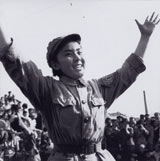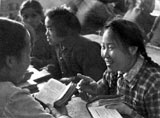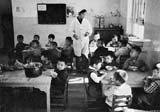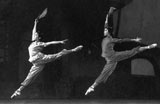The Experience of Socialism in the Soviet Union and China
Women's Liberation on the Cutting Edge
Revolution #038, March 12, 2006, posted at revcom.us
This is the text-only from a photo spread in Revolution. Get a copy of this issue of the newspaper to see the powerful images in this article.
"Socialist society is marked by new and different contradictions than the old society, and carrying forward the revolution under socialism depends on correctly identifying and dealing with those contradictions and the forces and struggles they set in motion. This brings up one very important factor in all this: the positive side of unresolved contradictions under socialism--the bringing to the fore of driving forces for revolutionary transformation in the socialist stage--forces on the cutting edge of contradictions that are coming to the fore as decisive questions in terms of whether society will be moved forward or dragged backward. A very important aspect of all this is the woman question, the struggle for the complete emancipation of women. This will be a decisive contradiction giving rise to crucial struggle throughout the socialist period."
Bob Avakian, Chairman of the RCP USA
from "The End of a Stage – The Beginning of a New Stage"
SOVIET UNION 1917-1956
The proletariat seized power in the Soviet Union in 1917 and began building a new socialist society. Before the revolution women faced widespread and horrible oppression. It was not unusual for women to be bought and sold as brides and servants. Women were treated as beasts of burden, on farms and in menial sweatshop jobs.
With the victory of the revolution came immediate and sweeping changes in the lives of women. New laws legally stripped men of authority over wives and children, ensured the right to divorce, and mandated equal pay for women. Marriage was made a civil, not church-sanctioned, ceremony. Maternity hospital care was free. Abortion was immediately decriminalized and then legalized in 1920. Prostitutes were no longer punished and prostitution was eventually eliminated. Child marriage was abolished as well as the selling of women. Work places provided maternity and abortion leave.
Lenin, the leader of the Russian revolution, said: "The experience of all liberation movements has shown that the success of a revolution depends on how much the women take part in it."
In the new socialist Soviet Union, the question of womens liberation was widely discussed and struggled over. There was lively debate in newspapers, women's magazines, schools, and workplaces -- about sex, marriage, the family and the role of women in the revolution. Oppressive and patriarchal customs were criticized and challenged.
Measures were taken to free women from the tasks of childcare, cooking, and cleaning. Communal kitchens and nurseries were set up in neighborhoods and at large factories. By 1920-21, 12 million people in the cities were eating together in communal cafeterias, over 80% of the people in Petrograd and 93% of the population in Moscow. Children were fed for free.
In the Soviet Central Asia, where many Muslims lived, women's revolutionary organizations encouraged women to reject the veil and take up new economic and social roles. In 1927 at a celebration of International Womens Day in Bukhara, 100,000 women tore off their veils and burned them. (Bukhara is in what is now Uzbekistan, which borders Afghanistan.) In a counter-revolutionary backlash, hundreds of women were attacked, and many murdered, by their husbands and fathers.
As a result of collectivization new opportunities opened up for women, to take jobs they had never be allowed to do before. Women took on political and administrative responsibilities in the management of collective farms. And in the home, the patriarchal authority of fathers and husbands was challenged. The campaign against illiteracy in the countryside was an important part of liberating women. At the start of the 1930s, less than 40% of rural women could read. By the end of that decade, over 70% could read.
CHINA 1949-1976
Mao Tsetung led the Chinese people to revolutionary victory in 1949. He said, "The Chinese people have stood up!" And women lifted their heads.
In 1950, a new marriage law put an end to arranged marriages and child brides and gave women the right to divorce. Women's associations struggled against men and other family memberswho expected women to do all the housework and childcare. And it was no longer "his business" when a man beat his wife -- women organized to confront and take strict measures against wife beaters.
Men were struggled with to share in the household tasks. At the same time, socializing things like cooking and childcare was an important part of liberating women and building a new society where people worked and lived in a cooperative and communal way. In the early 1950s a network of childcare facilities in city neighborhoods and rural villages was established, run by neighborhood organizations, factories, schools, or peasant cooperatives in the countryside.
The 1958-59 Great Leap Forward launched by Mao was a huge mass movement. It was a big step forward in economic development--especially in the countryside where peasants were mobilized to develop agriculture and small, local industry. It challenged feudal, oppressive traditions and thinking. Collective forms of farming were developed in the countryside and communes were established where tens of thousands of peasants lived and worked in common.
Socialized childcare helped free up millions of women to participate in building socialism. By 1952, the number of childcare centers in factories, mines, government organizations, and schools had expanded to 22 times what they had been in 1949. This trend continued throughout the 1950s, especially during the Great Leap Forward. By 1959, it was estimated that in rural areas there were almost five million childcare centers and kindergartens and more than 3.5 million public dining rooms. Some cities set up "meals on wheels" delivery services for people who were sick or had to stay home to take care of sick children. Childcare schedules were fitted in with the factory schedules and they were located as closely as possible to where the women worked.
In 1966 Mao launched the Great Proletarian Cultural Revolution, which was aimed at overthrowing those leaders right inside the Communist Party who wanted to bring back capitalism. Millions of people throughout society were mobilized to debate and struggle over whether China would continue building socialism or restore the nightmare of capitalism. The Cultural Revolution hit at all the backward traditions and practices of class society. And the struggle against women's oppression was a big part of this "revolution within the revolution." Mass campaigns were launched to criticize feudal Confucian and capitalist thinking that upheld oppressive and unequal divisions in society, like between mental and manual labor, town and countryside, and between men and women. There were new plays, ballets, and operas featuring women as strong central characters, that were popularized and produced throughout the country, including in remote rural areas. Young women in their millions participated in the Red Guards, who were a spark throughout society, challenging entrenched bureaucrats and party leaders who advocated capitalism.
In Maoist China, "women held up half the sky" in building a new socialist society.
The historic breakthroughs in women's liberation under socialism — in the Soviet Union from 1917 to 1956 and in China from 1949 to 1976 — were greater and went further than anything that has been achieved or is ever possible under capitalism. Today both of these countries are no longer socialist — proletarian state power was defeated by counter-revolution and capitalism was restored. Along with other aspects of exploitative bourgeois society, women's oppression has returned in full force.








